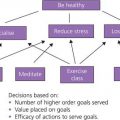The main goals of diabetes treatment are to prevent acute and long term complications and to improve quality of life (QOL) and avoid premature diabetes associated death.
Successful diabetes management relies on successful patient engagement as well as medical treatment, and regular assessment of education needs is as important as medical care.
Barrett (2011)
Introduction
Chapter 1 contains a brief outline of diabetes pathophysiology and diabetes management. It is the only place you will find these issues discussed in this book. Having a firm knowledge about these issues is essential for health professionals (HPs) to provide competent diabetes care. However, the main focus of the book is on the person with diabetes, not the disease, and encouraging HPs to reflect on and constantly evaluate their practice. These factors are encompassed in Barrett’s (2011) second statement; however, holistic, individualised care is missing from the statement and these are essential to achieve optimal outcomes.
Overview of diabetes
Diabetes mellitus (diabetes) occurs when the body’s capacity to utilise glucose, fat and protein is disturbed due to insulin deficiency or insulin resistance. If enough insulin is not produced or insulin action is defective, fat and protein stores are mobilised and converted into glucose to supply energy. However, fat metabolism requires insulin; therefore, insulin deficiency results in disordered fat metabolism and the intermediate products, ketone bodies, accumulate in the blood and cause ketosis, especially in type 1 diabetes (T1DM). Mobilisation of protein stores leads to weight loss and weakness and causes lethargy.
Different types of diabetes have different underlying causal mechanisms and present differently. Generally, young people are insulin-deficient and have T1DM and older people are insulin-resistant and have type 2 diabetes (T2DM). However, the classification of diabetes is not made according to age. T1DM occurs in about 10% of older people often as latent autoimmune diabetes (LADA). Likewise, T2DM is becoming more prevalent in children and adolescents as a consequence of inactivity, obesity and genetic predisposition (Barr et al. 2005; Zimmet et al. 2007). In addition, beta cell failure occurs gradually in T2DM with consequent insulin deficiency; therefore, more than 50% of people with T2DM eventually require insulin (UKPDS 1998). T2DM is the most common type, over 85% of diagnosed people, and approximately 15% of diagnosed people have T1DM. However, there are cultural variations in the prevalence of the two types (EURODIAB ACE Study Group 2000; DIAMOND Project Group 2006; Soltesz et al. 2006).
Prevalence of diabetes
Diabetes affects approximately 0.5–10% of the population depending on the diabetes type, age and ethnic group. Diabetes prevalence is increasing, particularly in the older people and in developing countries. In Western countries, the overall prevalence is 4–6% and up to 10–12% among 60–70-year-olds. The prevalence rises to ~20% in developing countries (Diabetes Atlas 2011). Most countries spend 6–12% of their annual health budgets on diabetes and its consequences. Most of the morbidity and mortality is associated with T2DM.
Overview of normal glucose homeostasis
Glucose homeostasis refers to the delicate balance between the fed and the fasting states and is maintained by several interrelated hormones, especially insulin, glucagon, adrenalin, cortisol, and the incretins, and nutritional status including liver and muscle glucose stores, the type of food consumed, exercise type and regularity, and tissue sensitivity to insulin. Insulin action is mediated via two protein pathways: protein 13-kinase through the insulin receptors in cells, which influences glucose uptake into the cells, and MAP-kinase, which stimulates growth and mitogenesis.
Insulin is secreted in two phases: In the first-phase, insulin secretion begins within 2 min of nutrient ingestion and continues for 10–15 min. A second phase of insulin secretion follows the first phase and is sustained until normoglycaemia is restored. The first phase demonstrates insulin sensitivity and beta cell responsiveness to a glucose load. The first phase helps limit the post-prandial rise in blood glucose. It is diminished or lost in T2DM; consequently, post-prandial blood glucose levels are often elevated (Dornhorst 2001). Post-prandial hyperglycaemia plays a leading role in the development of atherosclerosis, hypertriglyceridaemia, coagulopathies, endothelial dysfunction and hypertension. Together with chronic hyperglycaemia, these factors are responsible for long-term diabetes complications (Ceriello 2000).
A number of factors contribute to hyperglycaemia:
- Impaired glucose utilisation (IGT)
- Reduced glucose storage
- Inadequately suppressed glucose-mediated hepatic glucose production
- High fasting glucose (FPG)
- Reduced post-prandial glucose utilisation
In turn, hyperglycaemia leads to elevated free fatty acids (FFAs), which inhibit insulin signalling and glucose transport, but FFAs are a source of metabolic fuel for the heart and liver.
Signs and symptoms of diabetes
T1DM usually presents with the so-called classic symptoms of diabetes mellitus:
- Polyuria
- Polydipsia
- Lethargy
- Weight loss
- Hyperglycaemia
- Glycosuria
- Blood and urinary ketones; sometimes the person presents in diabetic ketoacidosis (DKA), a serious life-threatening emergency. DKA also develops during illnesses in T1DM. Insulin is essential to prevent DKA and increased doses are often required during illness. In hospital settings, insulin is usually administered in an intravenous insulin infusion.
T2DM is an insidious progressive disease that is often diagnosed when the person presents with a diabetes complication such as neuropathy, cardiovascular disease, nephropathy or retinopathy, or when the individual consults a HP for an illness or during health screening programmes. It is not ‘just a touch of sugar’ or ‘mild diabetes’. In fact, T2DM is also known as ‘the silent killer’, because the individual may not notice any symptoms. Therefore, population screening and education programmes are essential to enable early diagnosis and management.
The symptoms of T2DM are often less obvious than in T1DM; however, once T2DM diabetes is diagnosed and treatment is commenced, people often state they have more energy and feel less thirsty. Other signs of T2DM, especially in older people, include recurrent Candida infections, incontinence, constipation, dehydration and cognitive changes.
People most at risk of developing T2DM:
- Are overweight: abdominal obesity, increased body mass index (BMI), and a high waist–hip ratio. The specific parameters for these factors differ among some ethnic groups.
- Binge eating often precedes T2DM and contributes to obesity; however, the prevalence of eating disorders is similar in T1 and T2 diabetes (Herpertz et al. 1998).
- Are over age 40; but note there is increasing prevalence of T2DM in younger people.
- Have close relatives with T2DM.
- Are women who had gestational diabetes (GDM) or large babies.
- Currently smoke or smoked in the past (Kong et al. 2007).
- Are hypertensive, which is an independent predictor of T2DM (Conen et al. 2007).
- Insulin deficiency could be partly due to the enzyme PKC epsilon (PKCe), which is activated by fat, and inhibits insulin production (Biden 2007).
The majority of people with T2DM require multiple therapies to achieve and maintain acceptable blood glucose and lipid targets over the first 9 years after diagnosis (UKPDS 1998). Between 50% and 70% require insulin, which is often used in combination with oral glucose lowering medicines (GLM). This means diabetes management becomes progressively more complicated for people and increases the risk of medicine-related errors and adverse events as well as medicine non-compliance (see Chapter 11). The self-care regimen often becomes more demanding when the person is older, when their ability to self-manage may be compromised, which increases the likelihood of non-compliance and the costs of managing the disease for both the patient and the health system.
Gestational diabetes
Stay updated, free articles. Join our Telegram channel

Full access? Get Clinical Tree






